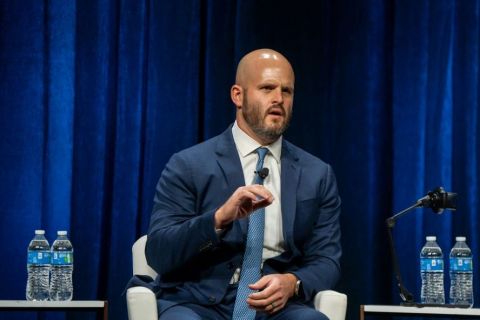Occidental Petroleum Corp. is a leading producer in the Permian Basin and its plans extend beyond oil and gas.
While producing a half-million boe/d from the Permian Basin, Oxy is reducing emissions, sustainably managing water, growing a leading CO₂-capture portfolio and more.
Babatunde Cole, the president and general manager of Occidental Petroleum’s Delaware Basin business unit, spoke with Hart Energy following his presentation at the Executive Oil Conference in Midland, Texas, about how the Permian Basin fits within Oxy’s sustainable goals.
Jordan Blum: What is Oxy doing with the groundbreaking direct air capture technology in the Permian, and where do things stand? What’s the timeline now?
Babatunde Cole (00:33): Yeah, really exciting opportunity for us with the direct air capture. Just to take stock of where we are today, we announced recently that we started early site construction on our first DAC here in Midland. We’re really excited. We went through an extensive front engineering design process and also did some testing and validation of the technology with carbon engineering to get us to where we are today. So, we’re definitely excited to break ground with some early construction. And based on the current timeline, we hope that it’s operational by late 2024.
JB: And this will literally be sucking CO₂ out the sky. Can you talk about how that fits with Oxy’s EOR focus?
BC (01:26): Yeah, I think they’re kind of two separate things. But on the DAC side, it’s an integral part of our net-zero strategy, direct air capture. What we want to do there is we want to remove carbon from the air running through a series of chemical reactions and create a pure CO₂ stream. And that CO₂ stream can either be permanently retired downhole, or it can be used to create other derivative products that add utility and value, whether it's construction materials, polymers. So, just really creating a carbon value chain with that process.
And our EOR comes in handy. We have 40 years of experience with carbon management. We have extensive knowledge of the subsurface and the surface processing facilities. And we feel like that expertise is going to be very vital for being able to manage carbon, whether it’s through retiring the carbon underground or using that carbon for other products in the future.
JB: Oxy just announced too, a new deal with the Historic King Ranch in South Texas to potentially do DAC plans there. Can you talk about how that might work out?
BC (02:45): Yeah, a really exciting agreement that we got done. We recently announced it. It’s a huge acreage position. It’s located perfectly in terms of just being close to an industrial hub, and the goal there is to facilitate the storage of CO₂ and the capture of CO₂ in that area. When you look at the King Ranch opportunity for us, I think from what we announced, it has about 3 billion tons of storage capacity, geological storage capacity, and over time, our goal is to scale up our annual carbon capture on that lease, peaking at about 30 million tons of carbon captured a year. So, really exciting opportunity for us, and yeah, we’re ready to get going.
JB: Oxy has talked about doing up to 30 DAC plants on the King Ranch acreage. I mean, that sounds really ambitious. What’s the potential timeline there?
BC (03:48): Without getting into a timeline specifically, I think one thing we’ve done well as a company, Oxy, is we were able to set ambitious goals and create bottoms up plans to hit those goals. I won’t put out a timeline, I’m not sure if we put one out already, but I can tell you that we have teams working hard to make it a reality.
JB: Certainly, a big part of the business going forward.
BC (04:17): Yes.
JB: Just going back to the Permian, Oxy is also doing a lot more with water recycling. How is that process going? How’s that fitting with the environmental goals?
BC (04:26): Oh, no, it’s huge for us. Like I said, during the conference, we’re in the water management business also. Parts of the Permian, you’re producing more water or just as much water as your oil. So, having a really good water management practice and a way to deploy technology to reduce your reliance on fresh water is key.
Again, Oxy is recognized as a leader in terms of our ability to have sound water management practices. We partner with universities, government organizations and private organizations to help educate on recycled produced water and other uses of recycled produced water. So, it’s huge for us.
We have recycling hubs in our core areas. We released that we recycled about 25 million barrels of water in our New Mexico operations in 2019, and we’re still recycling up until today. And in our Midland Basin operations, we’re recycling water at our South Curtis Ranch facility.
So again, huge goal for us is to continue that process and expanded long term.
Recommended Reading
From Restructuring to Reinvention, Weatherford Upbeat on Upcycle
2024-02-11 - Weatherford CEO Girish Saligram charts course for growth as the company looks to enter the third year of what appears to be a long upcycle.
TechnipFMC Eyes $30B in Subsea Orders by 2025
2024-02-23 - TechnipFMC is capitalizing on an industry shift in spending to offshore projects from land projects.
NOV's AI, Edge Offerings Find Traction—Despite Crowded Field
2024-02-02 - NOV’s CEO Clay Williams is bullish on the company’s digital future, highlighting value-driven adoption of tech by customers.
Patterson-UTI Braces for Activity ‘Pause’ After E&P Consolidations
2024-02-19 - Patterson-UTI saw net income rebound from 2022 and CEO Andy Hendricks says the company is well positioned following a wave of E&P consolidations that may slow activity.
ProPetro Reports Material Weakness in Financial Reporting Controls
2024-03-14 - ProPetro identified a material weakness in internal controls over financial reporting, the oilfield services firm said in a filing.





